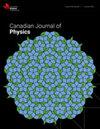Traversable Wormhole Models Supported by a String Cloud in Rainbow Gravity
IF 1
4区 物理与天体物理
Q3 PHYSICS, MULTIDISCIPLINARY
引用次数: 0
Abstract
The traversable wormholes are fascinating as the shortcuts in spacetime. This work discusses the geometry of a traversable wormhole with a string cloud as a source in rainbow gravity. The field equations are developed and solved to obtain the wormhole's shape function, cloud's mass density, and string tension. We have calculated the shape function and make it specific to study the dynamics for toy model. Based on the three well-known pairs of rainbow functions (mentioned by Ali and Khalil, 2015), the string cloud's dynamical variables including mass density and string tension are graphically presented. The corresponding energy conditions are also visually depicted. It is found that the source matter (string cloud) of the traversable wormhole must be exotic. However, the positive values of the string tension led to the presence of Casimir and dark energy effects. It is found that the toy model respects the null energy condition for a single pair of rainbow functions, i.e., Rainbow Function Type II. We have concluded that in rainbow gravity theory, the traversable wormhole solutions originating from a string cloud requires the presence of exotic matter to achieve a stable structure.彩虹重力中由弦云支持的可穿越虫洞模型
可穿越的虫洞就像时空中的捷径一样迷人。本作品讨论了彩虹引力中以弦云为源的可穿越虫洞的几何形状。建立并求解了场方程,得到了虫洞的形状函数、云的质量密度和弦张力。对玩具模型的形状函数进行了计算,并使其具体化。基于三对著名的彩虹函数(Ali and Khalil, 2015),我们用图形表示了弦云的动态变量,包括质量密度和弦张力。相应的能量条件也被直观地描绘出来。发现可穿越虫洞的源物质(弦云)一定是外来的。然而,弦张力的正值导致卡西米尔效应和暗能量效应的存在。发现玩具模型对单双彩虹函数,即彩虹函数II型,遵守零能条件。我们已经得出结论,在彩虹引力理论中,起源于弦云的可穿越虫洞解需要外来物质的存在才能获得稳定的结构。
本文章由计算机程序翻译,如有差异,请以英文原文为准。
求助全文
约1分钟内获得全文
求助全文
来源期刊

Canadian Journal of Physics
物理-物理:综合
CiteScore
2.30
自引率
8.30%
发文量
65
审稿时长
1.7 months
期刊介绍:
The Canadian Journal of Physics publishes research articles, rapid communications, and review articles that report significant advances in research in physics, including atomic and molecular physics; condensed matter; elementary particles and fields; nuclear physics; gases, fluid dynamics, and plasmas; electromagnetism and optics; mathematical physics; interdisciplinary, classical, and applied physics; relativity and cosmology; physics education research; statistical mechanics and thermodynamics; quantum physics and quantum computing; gravitation and string theory; biophysics; aeronomy and space physics; and astrophysics.
 求助内容:
求助内容: 应助结果提醒方式:
应助结果提醒方式:


